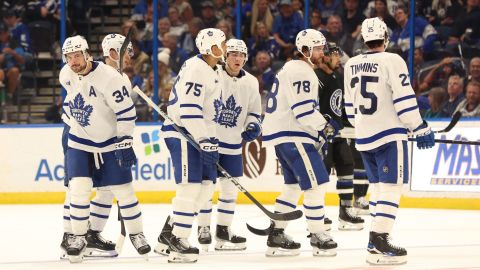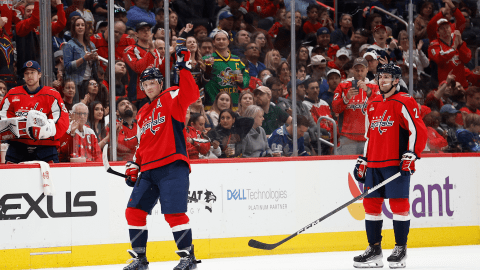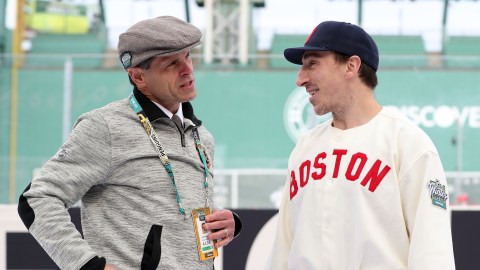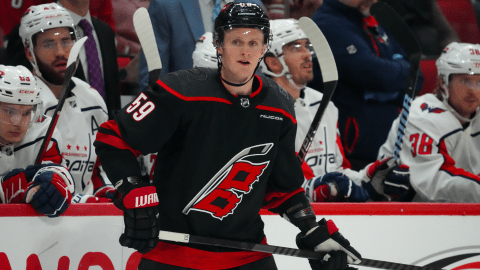We have almost reached the conference final stage of 2015 Stanley Cup playoffs. But for the teams that aren’t pursuing the best trophy in sports, the draft is the primary focus over the next few weeks and with good reason: This draft class is loaded with elite talent and great depth.
Here’s a 2015 mock draft for all 14 lottery picks and the teams that have been eliminated from the playoffs.
1) Edmonton Oilers: Connor McDavid, Center, Erie Otters (OHL)
Stats: 47 GP, 44 G, 76 A, 120 P
McDavid is the league’s next great star and the obvious choice despite Edmonton’s surplus of young, talented forwards. There’s nothing McDavid can’t do. He’s an excellent goal scorer, an elite playmaker, plays a responsible defensive game and reads/plays the game at a high speed.
The Oilers need a defenseman more than anything else, but they won’t pass on a player most people believe will perform on a Steven Stamkos, Sidney Crosby-type level offensively.
2) Buffalo Sabres: Jack Eichel, Center, Boston University (NCAA)
Stats: 40 GP, 26 G, 45 A, 71 P
Eichel is exactly what teams look for in a No. 1 center. He has all the offensive skills required to score goals, set up Grade-A chances for teammates, win faceoffs and drive puck possession. Very few players in the last 10 to 15 years have entered the draft with his level of size, skill and hockey smarts.
Put simply, Eichel is a franchise cornerstone player who could make an immediate impact alongside former 30-goal scorer Evander Kane on Buffalo’s top line.
3) Arizona Coyotes: Noah Hanifin, Defenseman, Boston College (NCAA)
Stats: 37 GP, 5 G, 18 A, 23 P
The Coyotes play a smart, defense-first style under head coach Dave Tippett, which makes Hanifin the best choice with this pick. The BC defenseman has a powerful shot, good playmaking skill, great defensive awareness and plays a physical game. He’s also capable of making a positive impact on both special teams units.
There will be a temptation to take Dylan Strome or Mitch Marner because players with No. 1 center talent are difficult to find, but the possibility of an Oliver Ekman-Larsson/Hanifin top pairing for the next decade is too good to pass up.
4) Toronto Maple Leafs: Dylan Strome, Center, Erie Otters (OHL)
Stats: 65 GP, 45 G, 84 A, 129 P
The Leafs have many needs heading into this draft, but none are more pressing than acquiring a No. 1 center. Strome is the type of playmaker who could help All-Star winger Phil Kessel reach the 40-goal mark for the first time. The Otters center has a high hockey IQ, great hands, protects the puck well and is able to make accurate passes in traffic. Oh, and by the way, Strome also possesses a great wrist shot and is capable of scoring lots of goals himself.
Strome is the best fit for Toronto unless the Coyotes pass on Hanifin.
5) Carolina Hurricanes: Ivan Provorov, Defenseman, Brandon Wheat Kings (WHL)
Stats: 60 GP, 15 G, 46 A, 61 P
Selecting Provorov at No. 5 might be a bit of a reach, but the Hurricanes already have enough depth at center to warrant passing on Strome and Marner, if available. This team’s No. 1 need is on the blue line, where All-Star Justin Faulk is the only legitimate first-pairing defenseman.
Much like Faulk, Provorov is a great skater and has the offensive skill set to quarterback a power play or create scoring chances at even strength. His ability to kill penalties and thrive in defensive situations make him one of the more well-rounded D-men in this class.
6) New Jersey Devils: Mitch Marner, Center, London Knights (OHL)
Stats: 63 GP, 44 G, 82 A, 126 P
The Devils lack young, high-end talent at center, which makes Marner the ideal choice. The Devils were among the league’s lowest scoring teams this season and lacked the playmaking skill down the middle that’s required to consistently create quality scoring chances. Marner is an excellent passer and isn’t afraid to unleash his powerful, accurate shot.
7) Philadelphia Flyers: Mathew Barzal, Center, Seattle Thunderbirds (WHL)
Stats: 44 GP, 12 G, 45 A, 57 P
The Flyers didn’t received much scoring production outside of top two forwards Claude Giroux and Jakub Voracek this season. It’s no secret they need more high-end offensive skill down the middle because Brayden Schenn and Sean Couturier don’t project, at least not right now, to be 60-plus point scorers in the NHL.
In addition to his quick release, Barzal gets plenty of power behind his shot and is accurate enough to beat goaltenders from tight angles or in traffic. He’s also a quality playmaker who thinks the game at a high speed.
8) Columbus Blue Jackets: Pavel Zacha, Center, Sarnia Sting (OHL)
Stats: 37 GP, 16 G, 18 A, 34 P
Zacha is a gifted skater with the ability to be a perennial 20-plus goal scorer. His size and willingness to play a physical game would fit in nicely with Columbus’ blue-collar style of hockey in which forwards are required to play defense, win puck battles, block shots, etc.
The Blue Jackets have found a No. 1 center with former fourth overall pick Ryan Johansen, who along with veteran Brandon Dubinsky and Zacha, could give Columbus excellent depth down the middle for many years.
9) San Jose Sharks: Mikko Rantanen, Right Wing, TPS (Finland)
Stats: 56 GP, 9 G, 19 A, 28 P
San Jose’s prospect pool lacks high-end offensive talent among forwards, which is a problem given the age of many of their top-six forwards at the NHL level. Rantanen’s playmaking skill, speed and versatility — he can generate offense from center or right wing — would be a fantastic fit with the Sharks.
10) Colorado Avalanche: Jakub Zboril, Defenseman, Saint John Sea Dogs (QMJHL)
Stats: 44 GP, 13 G, 20, 33 P
Zboril would provide the defensive awareness, physical play and penalty killing ability that were absent on the Colorado blue line for large portions of this season. The Avalanche struggled to control puck possession, win battles in their own end and transition quickly up ice. Zboril will address these issues with his two-way skill set and high hockey IQ.
11) Florida Panthers: Zach Werenski, Defenseman, Mighigan (NCAA)
Stats: 35 GP, 9 G, 16 A, 25 P
The Panthers have a solid foundation on the blue line with young defensemen Dmitry Kulikov, Eric Gudbranson and Calder Trophy finalist Aaron Ekblad all 24 years old or younger. Florida should add to this impressive group by selecting Werenski, who compares to another two-way defenseman from Michigan: Jacob Trouba of the Winnipeg Jets.
12) Dallas Stars: Jeremy Roy, Defenseman, Sherbrooke Phoenix (QMJHL)
Stats: 46 GP, 5 G, 43 A, 43 P
The Stars’ inability to consistently defend well or suppress opponents’ shot attempts should result in general manager Jim Nill addressing the blue line with this pick. Roy is a smart player coaches can trust in any situation, whether it’s at even strength, the power play or penalty kill. He’s a very good defensive player with his ability to read plays, break up passes and fundamentally strong positioning. He’s the perfect fit for the Stars blue line.
13) Los Angeles Kings: Thomas Chabot, Defenseman, Saint John Sea Dogs (QMJHL)
Stats: 66 GP, 12 G, 29 A, 41 P
The Kings lost Willie Mitchell in free agency last summer, were without Slava Voynov for most of the season because of legal issues and now must replace the retired veteran Robyn Regehr. Losing three defensemen makes the selection of a blueliner a no-brainer.
Chabot is the best fit for L.A. because he’s strong enough to play its bruising style of hockey and has enough mobility/puck-moving skill to play an uptempo game. The only problem for the Kings is he, might not be available.
14) Boston Bruins: Timo Meier, Left Wing, Halifax Mooseheads (QMJHL)
Stats: 61 GP, 44 G, 46 A, 90 P
Boston should select Meier — if he’s even available — because the Swiss winger is able to play a physical game while also possessing the high-end skill to create scoring chances for himself and linemates with excellent vision and an accurate shot.
The Mooseheads have done a brilliant job developing skilled wingers over the last few years, most notably Jonathan Drouin (No. 3 overall in 2013) and Nikolaj Ehlers (No. 9 overall in 2014). Meier played a lot of right wing in Halifax, but he could also move to the left side because of his left-handed shot. That would benefit the Bruins because left wing is a position of need throughout the organization.
Another positive for Meier is he’s one of the more NHL-ready forwards in this class, which is good for a team like the Bruins in win-now mode.
15) Calgary Flames: Lawson Crouse, Left Wing, Kingston Frontenacs (OHL)
Stats: 56 GP, 29 G, 22 A, 51 P
Calgary president of hockey operations Brian Burke always has been a fan of physical forwards. That’s how he built his Ducks and Leafs teams, and he’s taken a somewhat similar approach in Calgary, although general manager Brad Treliving deserves a lot of credit for the team’s recent success.
Crouse is a high-risk/high-reward prospect, so it’s difficult to project where the 6-foot-4, 212-pound winger will be drafted. He could go top seven or slip into the middle of the first round.
He’s a prototypical power forward and a smart defensive player, but his offensive game still needs a fair amount of work. Crouse is a bit of a gamble, but the possible reward — a Milan Lucic-type skill set if he reaches his full potential — is enticing.
16) Edmonton Oilers (via PIT): Paul Bittner, Left Wing, Portland Winterhawks (WHL)
Stats: 64 GP, 34 G, 37 A, 71 P
The Oilers need to be tougher to play against, and Bittner would help address this concern with his 6-foot-4, 195-pound frame. His blend of size skill makes him an intriguing prospect. He has a powerful shot and above-average passer, but his offensive game as a whole is still a work in progress.
Edmonton needs a defenseman, but there might not be any worth taking with this pick unless Chabot or Roy fall. Left wing is another position the Oilers should add some depth in through the draft.
17) Winnipeg Jets: Nick Merkley, Center/RW, Kelowna Rockets (WHL)
Stats: 72 GP, 20 G, 70 A, 90 P
The Jets could take a defenseman if one falls to them, but Merkley would be a solid addition to an already deep group of forwards in Winnipeg’s prospect pool. He’s a bit undersized at 5-foot-10, but he has the playmaking skill and power-play ability to become a factor offensively at the NHL level.
18) Ottawa Senators: Kyle Connor, LW/C, Youngstown Phantoms (USHL)
Stats: 56 GP, 34 G, 46 A, 80 P
Connor is a hard-working, intelligent forward with an impressive two-way skill set. He creates scoring chances for himself and teammates, while understanding the importance of defensive positioning and the need to go to the dirty areas for pucks. He’s still two or three years away from making an impact in the NHL, but the Senators can afford to wait given the number of talented young forwards already on the pro roster.
19) Detroit Red Wings: Oliver Kylington, Defenseman, Farjestad (Sweden)
Stats: 35 GP, 6 G, 6 A, 12 P (between Farjestad and AIX)
The Red Wings had only two defensemen tally more than 18 points last season, and No. 1 blueliner Niklas Kronwall is past the prime of his career. With no elite defenseman prospects in the system, Kylington makes sense for the Red Wings. He’s a very good skater, moves the puck well and has excellent offensive instincts.
20) Minnesota Wild: Travis Konecny, Center/RW, Ottawa 67’s (OHL)
Stats: 60 GP, 29 G, 39 A, 68 P
The Wild didn’t score enough goals in the playoffs and received subpar performances from a lot of forwards, including highly paid veterans Zach Parise and Thomas Vanek.
Konecny would provide valuable versatility with his ability to score goals at center or on the wing. He’d also be a good fit in the Wild’s hard-working style with his tireless work ethic and willingness to fight for pucks.
21) Buffalo Sabres (via NYI): Brandon Carlo, Defenseman, Tri-City Americans (WHL)
Stats: 63 GP, 4 G, 21 A, 25 P
It makes sense for the Sabres to address their blue line depth with this pick. Carlo is a smart, stay-at-home defenseman who punishes opponents with physical play at 6-foot-4, 200 pounds and is able to see plays before they develop. He could also play a key role on the penalty kill and other defensive situations with his ability to make the simple play in getting the puck out of the zone.
22) Vancouver Canucks: Evgeny Svechnikov, LW, Cape Breton Screaming Eagles (QMJHL)
Stats: 55 GP, 32 G, 46 A
Svechnikov has elite offensive skill, skates well and plays the game at a high speed both physically and mentally. That said, he still needs work defensively. The Canucks have selected several forwards in the first round during the last couple of drafts, but passing on a talent as good as Svechnikov would be foolish.
23) Toronto Maple Leafs (via NSH): Jordan Greenway, LW, USA U-18 (USHL)
Stats: 22 GP, 5 G, 15 A, 20 P
Greenway plays a power forward-type of game at 6-foot-4, 220 pounds. He enjoys having the puck on his stick, has a very accurate shot, protects the puck well and will battle for possession all over the ice — and usually come out with the puck, thanks to his size.
The Leafs are in the midst of a rebuild and can afford to give Greenway the time required to develop his offensive talent and learn how to best use his physical frame.
24) Winnipeg Jets (from STL via BUF): Jansen Harkins, Center, Prince George Cougars (WHL)
Stats: 70 GP, 20 G 59, 79 P
Harkins is a well-rounded center. In addition to his responsible defensive play, he’s capable of creating chances for teammates with excellent passes and great vision. He slows the game down and reads situations in order to make smart decisions with the puck.
Harkins projects to be a top-six NHL forward with an impressive two-way skill set. That’s a type of player Winnipeg needs at the NHL level and throughout its prospect pool.
Thumbnail photo via Twitter/@CCMHockey



